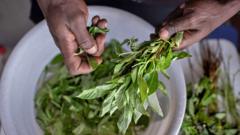A heated debate has erupted between the German states of Bavaria and Thuringia regarding the true origin of the iconic Bratwurst sausage. The "Wurstkuchl" tavern in Regensburg, Bavaria, has long proclaimed to be the oldest Bratwurst stand in the world, boasting a history that dates back to 1378. This establishment, located on the historic Stone Bridge over the Danube River, has attracted countless patrons with its traditional culinary offerings.
However, recent discoveries by historians in Erfurt, the capital of Thuringia, have revealed a document from 1269 referring to a meat-roasting stand (Brathütte) which predates the Bavarian claims by over a century. These findings have prompted historians to seek out the original location of the alleged sausage stand in Erfurt, although no restaurant there currently makes a similar claim to fame.
For years, the earliest documented reference to Bratwursts in Thuringia was believed to come from 1404, detailing an expenditure of "1 groschen for bratwurst casings" in Arnstadt. Meanwhile, the Wurstkuchl in Regensburg proudly continues its legacy, emphasizing that its methods and recipes have remained largely unchanged since medieval times. The tavern claims to serve sausages made from pure pork ham, alongside homemade sauerkraut and a signature mustard.
In response to Thuringia's recent historical revelations, the Wurstkuchl's landlady, Alexandra Meier, stated in an interview with German BR24 TV that the debate does not concern her greatly. She expressed pride in the quality of the sausages produced by her family and the enduring reputation of the establishment. "I don't think people will say, 'I'm not going there anymore because it's only the second oldest,'" she remarked.
This argument over the Bratwurst's origins is not unprecedented, as Bavarian towns like Regensburg and Nuremberg have previously tussled over the title of the oldest sausage stand, with Regensburg having emerged victorious in the past. The passionate discourse surrounding this culinary staple continues as both regions defend their historical narratives and celebrate their contributions to German gastronomy.











